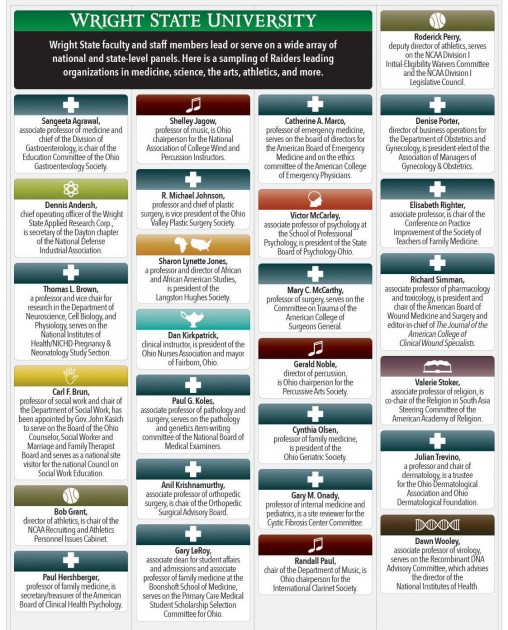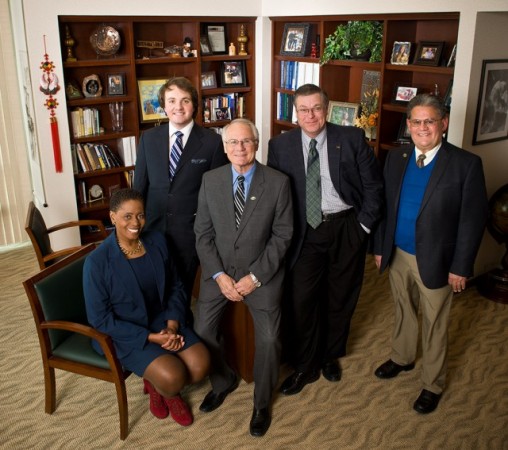Leaders are special people. They are usually intelligent and charismatic with vision and values. People naturally just want to follow them.
Wright State University is teeming with such leaders. They hold high national and state positions and populate influential organizations in education, science, labor, health, athletics, and the arts.
David R. Hopkins, president of Wright State University, is chair of the Inter-University Council of Ohio, member of the Higher Education Capital Funding Commission of Ohio, and serves on the National Collegiate Athletic Association, Division I, Executive Committee and Board of Directors. He is also chair of the Wright Brothers Institute, vice chair of the Advanced Technical Intelligence Center, and co-chair of the Ohio Board of Regents Articulation and Transfer Advisory Council.
Dan Krane, professor of biology, is chair of the Ohio Faculty Council. He represents the faculty at Ohio’s 13 public, four-year universities when he speaks to the chancellor, the Board of Regents, and state legislatures. The council passes resolutions on matters before the Ohio House and Senate and coordinates activities between universities on curricular issues such as the transition from quarters to semesters.
Tony Ortiz, associate vice president for Latino affairs, is commissioner on the Ohio Commission of Hispanic/Latino Affairs. The commission advises the governor, General Assembly, and state agencies on matters affecting Hispanic Ohioans by issuing reports, proposing programs, commenting on legislation, and conducting policy-related research. Its mission is to connect the diverse Latino communities across the state and to build the capacity of Latino community organizations. Ortiz is also the state vice president for the Elderly-League of United Latin American Citizens, which works to advance the economic condition, educational attainment, political influence, housing, health, and civil rights of the Hispanic population of the United States.
Rudy Fichtenbaum, professor of economics, is president of the American Association of University Professors. The mission of the AAUP, which represents about 47,000 professors and other academics, is to advance academic freedom and shared governance; to define fundamental professional values and standards for higher education; to promote the economic security of faculty, academic professionals, graduate students, post-doctoral fellows, and all those engaged in teaching and research in higher education; to help the higher education community organize to make its goals a reality; and to ensure higher education’s contribution to the common good. Founded in 1915, the AAUP has helped to shape American higher education by developing the standards and procedures that maintain quality in education and academic freedom in this country’s colleges and universities. Fichtenbaum has authored more than 45 articles and book chapters on topics such as discrimination, income distribution, and the impact of unions on wages and benefits.
Spencer Brannon, a senior majoring in political science and economics, is chairman of the Ohio Student Government Association, one of the nation’s largest entirely student-led intercollegiate organizations. It represents the views and interests of the students and student governments of institutions of higher education in Ohio. “It is deeply humbling to serve as the face and voice of an organization that represents over half a million students to government leaders from the Board of Regents to the U.S. Department of Education and to know that the work I do on their behalf is making their student experiences—and their lives— that much easier.”
Simone Polk, assistant vice president for student services, serves on the Ohio Reach Advisory Board. Former foster youth are a severely underrepresented, underserved, and undersupported population in higher education institutions. Ohio Reach works to improve the post-secondary success of foster care youth and alumni through advocacy, leadership, networking, and empowerment.
 This article originally appeared in the spring 2014 issue of the Wright State University Magazine.
This article originally appeared in the spring 2014 issue of the Wright State University Magazine.


 Joe Gruenberg’s 40-Year support for Wright State celebrated with Honorary Alumnus Award
Joe Gruenberg’s 40-Year support for Wright State celebrated with Honorary Alumnus Award  Wright State’s elementary education program earns A+ rating for math teacher training
Wright State’s elementary education program earns A+ rating for math teacher training  Wright State’s Calamityville hosts its largest joint medical training operation
Wright State’s Calamityville hosts its largest joint medical training operation  Wright State University launches Strategic Plan 2030 to advance student success, enhance role as regional economic driver
Wright State University launches Strategic Plan 2030 to advance student success, enhance role as regional economic driver  Pete and Pam Julian create scholarships to help current and future generations of Wright State students
Pete and Pam Julian create scholarships to help current and future generations of Wright State students 